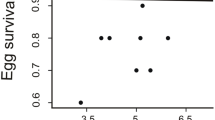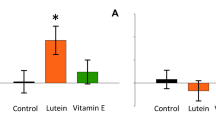Abstract
Chromatic signals of offspring quality have been shown to play a role in parent–offspring communication in diurnal birds, but are assumed to be useless in dim light conditions because colour-based discrimination probably requires more light. A major ecological and evolutionary conundrum in this scenario is why the nestlings of some nocturnal owls display colourful beaks. Here, we test the hypothesis that yellow bill coloration of owlets of the nocturnal little owl Athene noctua may function as a chromatic signal revealing to parents aspects of quality of their offspring. In a first step, we examined physical variation in bill coloration and its covariation with owlet quality. Secondly, we studied parental provisioning in relation to an experimental manipulation of bill coloration of owlets. Bills of owlets showed higher within-nest variation in yellow–red chroma than in brightness. Plasma carotenoid concentration and nestling immunological status were not associated with chromatic or achromatic features of the bill. Interestingly, however, heavier owlets displayed more yellow bills than lighter ones. The effect of bill coloration on parental favouritism changed with brood size. Parents holding large broods preferentially fed owlets with enhanced over reduced yellow bill coloration, whereas those with small broods did not significantly bias feeding in relation to owlet bill coloration. Our results, based on integration of objective spectrophotometric assessment of colour and experimental procedures, confirm that parent little owls use bill coloration to reveal information on owlet body mass to adjust their feeding strategies, thus highlighting the importance of considering potential chromatic signals for a full comprehension of parent–offspring communication processes in nocturnal bird species.




Similar content being viewed by others
References
Alonso-Alvarez C, Tella JL (2001) Effects of experimental food restriction and body-mass changes on the avian T-cell-mediated immune response. Can J Zool 79:101–105
Aragonés J, de Reyna LA, Recuerda P (1999) Visual communication and sexual selection ln a nocturnal bird species, Caprimulgus ruficollis, a balance between crypsis and conspicuousness. Wilson Bull 111:340–345
Avilés JM, Parejo D (2012) Covariation between bill coloration and fitness components in a nocturnal bird. J Avian Biol (in press) doi:10.1111/j.1600-048X.2012.05819.x
Avilés JM, Soler JJ (2009) Nestling coloration is adjusted to parent visual performance in altricial birds. J Evol Biol 22:376–386
Avilés JM, Pérez-Contreras T, Navarro C, Soler JJ (2008) Dark nests and conspicuousness in color patterns of nestlings of altricial birds. Am Nat 171:327–338
Avilés JM, Parejo D, Rodríguez J (2011) Parental favouritism strategies in the asynchronously hatching European Roller (Coracias garrulus). Behav Ecol Sociobiol 65:1549–1557
Bize P, Piault R, Moureau B, Heeb P (2006) A UV signal of offspring condition mediates context-dependent parental favouritism. Proc R Soc Lond B 273:2063–2068
Bortolotti GR, Tella JL, Forero MG, Dawson RD, Negro JJ (2000) Genetics, local environment and health as factors influencing plasma carotenoids in wild American kestrels (Falco sparverius). Proc R Soc Lond B 267:1433–1438
Bortolotti GR, Fernie KJ, Smits JE (2003) Carotenoid concentration and coloration of American Kestrels (Falco sparverius) disrupted by experimental exposure to PCBs. Funct Ecol 17:651–657
Bowmaker JK, Martin GR (1978) Visual Pigments and Color-Vision in A Nocturnal Bird, Strix aluco (Tawny Owl). Vis Res 18:1125–1130
Cramp S (1998) Cramp’s the complete birds of the Western palearctic. Optimedia, Oxford University Press, Oxford
de Ayala RM, Saino N, Møller AP, Anselmi C (2007) Mouth coloration of nestlings covaries with offspring quality and influences parental feeding behavior. Behav Ecol 18:526–534
Del Hoyo J, Elliott A, Sargatal J (1999) Handbook of the birds of the world, vol 5: Barn owls to hummingbirds. Lynx, Barcelona.
Dugas MB (2009) House sparrow, Passer domesticus, parents preferentially feed nestlings with mouth colours that appear carotenoid-rich. Anim Behav 78:767–772
Dugas MB, Mcgraw KJ (2011) Proximate correlates of carotenoid-based mouth coloration in nestling house sparrows. Condor 113:691–700
Endler JA, Westcott DA, Madden JR, Robson T (2005) Animal visual systems and the evolution of color patterns: sensory processing illuminates signal evolution. Evolution 59:1795–1818
Ewen JG, Thorogood R, Karadas F, Cassey P (2008) Condition dependence of nestling mouth colour and the effect of supplementing carotenoids on parental behaviour in the hihi (Notiomystis cincta). Oecologia 157:361–368
Faivre B, Gregorie A, Preault M, Cezilly F, Sorci G (2003) Immune activation rapidly mirrored in a secondary sexual trait. Science 300:103
Ficken MS (1965) Mouth color of nestling passerines and its use in taxonomy. Wilson Bull 77(71–75):1965
Galván I, Amo L, Sanz JJ (2008) Ultraviolet-blue reflectance of some nestling plumage patches mediates parental favouritism in great tits Parus major. J Avian Biol 39:277–282
Griggio M, Morosinotto C, Pilastro A (2009) Nestlings’ carotenoid feather ornament affects parental allocation strategy and reduces maternal survival. J Evol Biol 22:2077–2085
Hardouin LA, Robert D, Bretagnolle V (2008) A dusk chorus effect in a nocturnal bird: support for mate and rival assessment functions. Behav Ecol Sociobiol 62:1909–1918
Hart NS, Hunt DM (2007) Avian visual pigments: characteristics, spectral tuning, and evolution. Am Nat 169:S7–S26
Heeb P, Schwander T, Faoro S (2003) Nestling detectability affects parental feeding preferences in a cavity-nesting bird. Anim Behav 66:637–642
Jacot A, Romero-Diaz C, Tschirren B, Richner H, Fitze PS (2010) Dissecting carotenoid from structural components of carotenoid-based coloration: a field experiment with great tits (Parus major). Am Nat 176:55–62
Jourdie V, Moureau B, Bennett ATD, Heeb P (2004) Ultraviolet reflectance by the skin of nestlings. Nature 431:262
Karubian J, Lindsay WR, Schwabl H, Webster MS (2011) Bill coloration, a flexible signal in a tropical passerine bird, is regulated by social environment and androgens. Anim Behav 81:795–800
Kelber A, Lind O (2010) Limits of colour vision in dim light. Ophthalmic Physiol Opt 30:454–459
Kelber A, Vorobyev M, Osorio D (2003) Animal colour vision–behavioural tests and physiological concepts. Biol Rev 78:81–118
Kilner R (1997) Mouth colour is a reliable signal of need in begging canary nestlings. Proc R Soc Lond B 264:963–968
Kilner RM (2006) Function and evolution of color in young birds. In: Hill G, McGraw K (eds) Bird coloration: function and evolution, vol 2. Harvard University Press, Cambridge, pp 201–232
Kilner R, Davies NB (1998) Nestling mouth colour: ecological correlates of a begging signal. Anim Behav 56:705–712
Laaksonen T, Negro JJ, Lyytinen S, Valkama J, Ots I, Korpimaki E (2008) Effects of experimental brood size manipulation and gender on carotenoid levels of eurasian kestrels Falco tinnunculus. PLoS One 3:e2374
Leclaire S, White J, Arnoux E, Faivre B, Vetter N, Hatch SA, Danchin E (2011) Integument coloration signals reproductive success, heterozygosity, and antioxidant levels in chick-rearing black-legged kittiwakes. Naturwissenschaften 98:773–782
Lind O, Kelber A (2009) The intensity threshold of colour vision in two species of parrot. J Exp Biol 212:3693–3699
Martin GR (1974) Color-vision in tawny owl (Strix-Aluco). J Comp Physiol 86:133–141
Martin GR (1990) Birds by night. Poyser, London
Mcgraw KJ, Hill GE, Navara KJ, Parker RS (2004) Differential accumulation and pigmenting ability of dietary carotenoids in colorful finches. Physiol Biochem Zool 77:484–491
Mock DW, Dugas MB, Strickler SA (2011) Honest begging: expanding from signal of need. Behav Ecol 22:909–917
Navarro C, Perez-Contreras T, Avilés JM, Mcgraw KJ, Soler JJ (2010) Beak colour reflects circulating carotenoid and vitamin A levels in spotless starlings (Sturnus unicolor). Behav Ecol Sociobiol 64:1057–1067
Negro JJ, de la Riva MJ, Hiraldo F (1990) Daytime activity of little owls (Athene noctua) in southwestern Spain. J Raptor Res 24:72–74
Parejo D, Avilés JM (2011) Predation risk determines breeding territory choice in a Mediterranean cavity-nesting bird community. Oecologia 165:185–191
Parejo D, Avilés JM, Rodriguez J (2010) Visual cues and parental favouritism in a nocturnal bird. Biol Lett 6:171–173
Penteriani V, Delgado MD (2009) The dusk chorus from an owl perspective: eagle owls vocalize when their white throat badge contrasts most. PLoS One 4:e4960
Penteriani V, Delgado MD, Alonso-Alvarez C, Pina NV, Sergio F, Bartolommei P, Thompson LJ (2007a) The importance of visual cues for nocturnal species: Eagle owl fledglings signal with white mouth feathers. Ethology 113:934–943
Penteriani V, Delgado MD, Alonso-Alvarez C, Sergio F (2007b) The importance of visual cues for nocturnal species: eagle owls signal by badge brightness. Behav Ecol 18:143–147
Pérez-Rodríguez L, Mougeot F, Bortolotti GR (2011) The effects of preen oils and soiling on the UV-visible reflectance of carotenoid-pigmented feathers. Behav Ecol Sociobiol 65:1425–1435
Peters A, Denk AG, Delhey K, Kempenaers B (2004) Carotenoid-based bill colour as an indicator of immunocompetence and sperm performance in male mallards. J Evol Biol 17:1111–1120
Piault R, Gasparini J, Bize P, Paulet M, Mcgraw KJ, Roulin A (2008) Experimental support for the makeup hypothesis in nestling tawny owls (Strix aluco). Behav Ecol 19:703–709
Prum RO, Torres R (2003) Structural coloration of avian skin: convergent evolution of coherently scattering dermal collagen arrays. J Exp Biol 206:2409–2429
Quinn GP, Keough MJ (2002) Experimental design and data analysis for biologists. Cambridge University Press, Cambridge
Rodríguez J, Avilés JM, Parejo D (2011) The value of nestboxes in the conservation of Eurasian Rollers Coracias garrulus in southern Spain. Ibis 153:735–745
Saino N, Ninni P, Calza S, Martinelli R, De Bernardi F, Møller AP (2000) Better red than dead: carotenoid-based mouth coloration reveals infection in barn swallow nestlings. Proc R Soc Lond B 267:57–61
Saino N, Ambrosini R, Martinelli R, Ninni P, Møller AP (2003) Gape coloration reliably reflects immunocompetence of barn swallow (Hirundo rustica) nestlings. Behav Ecol 14:16–22
Smits JE, Bortolotti GR, Tella JL (1999) Simplifying the phytohaemagglutinin skin-testing technique in studies of avian immunocompetence. Funct Ecol 13:567–572
Soler JJ, Avilés JM, Cuervo JJ, Pérez-Contreras T (2007) Is the relation between colour and immune response mediated by nutritional condition in spotless starling nestlings? Anim Behav 74:1139–1145
Tanner M, Richner H (2008) Ultraviolet reflectance of plumage for parent-offspring communication in the great tit (Parus major). Behav Ecol 19:369–373
Tella JL, Negro JJ, Rodríguez-Estrella R, Blanco G, Forero MG, Blázquez MC, Hiraldo F (1998) A comparison of spectrophotometry and color charts for evaluating total plasma carotenoids in wild birds. Physiol Zool 71:708–711
Thorogood R, Kilner RM, Karadas F, Ewen JG (2008) Spectral mouth colour of nestlings changes with carotenoid availability. Funct Ecol 22:1044–1051
Thorogood R, Ewen JG, Kilner RM (2011) Sense and sensitivity: responsiveness to offspring signals varies with the parents’ potential to breed again. Proc R Soc Lond B 278:2638–2645
Velando A, Beamonte-Barrientos R, Torres R (2006) Pigment-based skin colour in the blue-footed booby: an honest signal of current condition used by females to adjust reproductive investment. Oecologia 149:535–542
Vorobyev M, Osorio D (1998) Receptor noise as a determinant of colour thresholds. Proc R Soc Lond B 265:351–358
Vorobyev M, Osorio D, Bennett ATD, Marshall NJ, Cuthill IC (1998) Tetrachromacy, oil droplets and bird plumage colours. J Comp Physiol A 183:621–633
Vorobyev M, Brandt R, Peitsch D, Laughlin SB, Menzel R (2001) Colour thresholds and receptor noise: behaviour and physiology compared. Vision Res 41:639–653
Wiebe KL, Slagsvold T (2009) Mouth coloration in nestling birds: increasing detection or signalling quality? Anim Behav 78:1413–1420
Acknowledgments
This research was funded by the Spanish Ministry of Education and Science/FEDER (CGL2008-00718) and the Spanish Ministry of Economy and Competitiveness/FEDER (CGL2011-27561) to J.M.A. and D.P. The authors thank Juan Rodríguez, Esther Campanario, Isaac Abdel and Fernando Goytre for their assistance in the field and in the laboratory and two anonymous referees for their constructive comments.
Author information
Authors and Affiliations
Corresponding author
Additional information
Communicated by Oliver Love.
Electronic supplementary material
Below is the link to the electronic supplementary material.
Rights and permissions
About this article
Cite this article
Avilés, J.M., Parejo, D. Colour also matters for nocturnal birds: owlet bill coloration advertises quality and influences parental feeding behaviour in little owls. Oecologia 173, 399–408 (2013). https://doi.org/10.1007/s00442-013-2625-8
Received:
Accepted:
Published:
Issue Date:
DOI: https://doi.org/10.1007/s00442-013-2625-8




